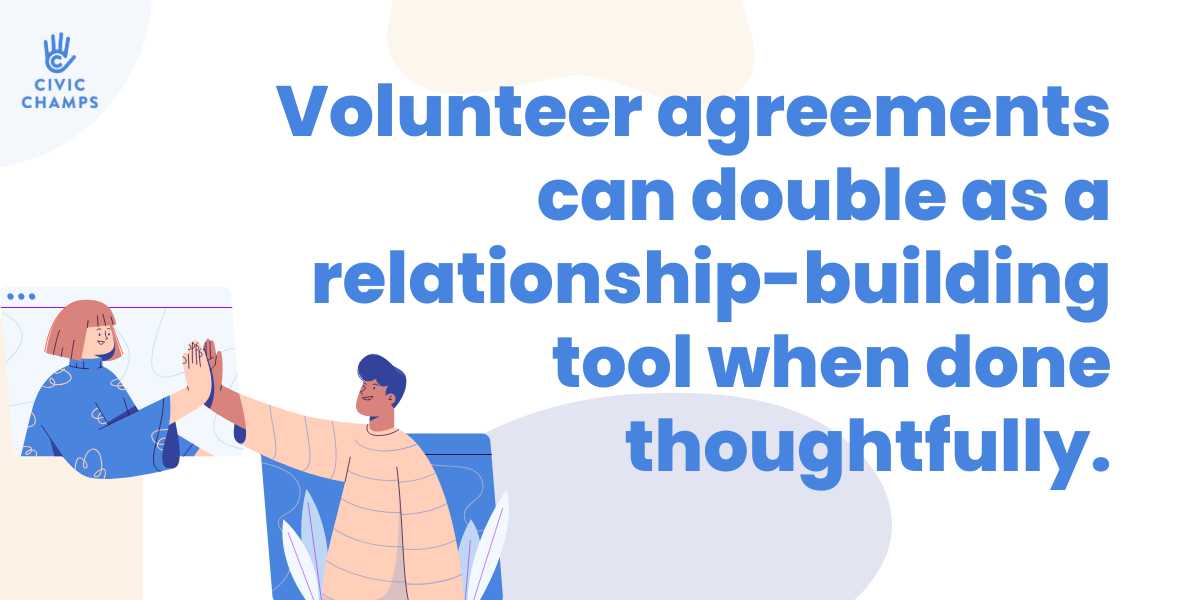Volunteers are the lifeblood of every nonprofit, but even the most routine activities carry some risk. A child could trip during a park cleanup, a box could be dropped at a food pantry, or a volunteer might injure themselves while setting up for a fundraiser. That’s why volunteer waivers are such an important tool. They don’t erase all liability, but they help set clear expectations, protect your organization, and build trust by showing volunteers you take their safety seriously.
Many nonprofits don’t create their own documents from scratch. They adapt what’s worked for peers and rely on legal template services for structure, consulting with attorneys as needed to ensure they have covered all of their legal bases for their unique circumstances. Below, you’ll find real-world volunteer waivers examples and guidance you can use to strengthen your own forms.
What is an example of a waiver?
At its core, a waiver is a document where someone gives up the right to sue for injuries or damages tied to a specific activity. In a volunteer setting, that means acknowledging potential risks before participating. For example, the Food Bank of York Region in Ontario uses a volunteer waiver that spells out the risks of working in a warehouse environment, includes a release of liability, and collects emergency contact information (Food Bank of York Region). Their form is simple, clear, and written in plain language, which makes it approachable for volunteers while still protecting the nonprofit.
Beyond the basics, waivers often include details that make them more usable for everyone.
- A clear title and date so volunteers know what they’re signing
- Simple language that avoids legal jargon
- A signature section for adults and guardians of minor
Adding these pieces creates a waiver that is protective without being intimidating. Volunteers leave feeling informed, not overwhelmed.
What is an example of an agreement?
A volunteer agreement is different from a waiver because it focuses on expectations rather than liability. It’s about clarity surrounding what the nonprofit will provide, what’s expected from the volunteer, and how both parties will work together. The University of Florida provides a sample volunteer agreement that nonprofits can adapt, which covers roles, duties, and expectations in straightforward language (University of Florida Sample Agreement). This kind of template shows how U.S. organizations set out terms that reduce misunderstandings and create a better volunteer experience.
Volunteer agreements can double as a relationship-building tool when done thoughtfully.
- Outline scheduling and time commitments
- Define communication preferences and channels
- State what training or supervision will be offered
By making expectations mutual, agreements help volunteers feel like true partners in your mission. This clarity builds trust and loyalty over time.

What is an example of a volunteer liability waiver?
A volunteer liability waiver zeroes in on protecting your organization from claims that could arise out of volunteer activities. Habitat for Humanity has a great example of a liability waiver that’s perfectly suited to their work. Their form includes assumption of risk clauses tailored to construction work, medical consent language, and a photographic release. By addressing the specific kinds of labor their volunteers perform, they demonstrate how effective waivers go beyond generic wording to reflect the realities of the work.
What is a volunteer waiver?
A volunteer waiver is the umbrella term for these types of documents. Whether it’s called a release, waiver, or assumption of risk form, the purpose is the same: make sure volunteers understand the potential dangers of their activities and formally agree to accept those risks. These forms are especially important when the activities involve physical tasks or outdoor work. Reviewing multiple examples helps you find a balance between covering your bases and keeping the form accessible.
Do waivers stop you from suing?
One of the most common misconceptions is that waivers completely prevent lawsuits. In reality, a waiver can reduce exposure but doesn’t guarantee protection. Courts often look at whether the waiver was clear, whether the volunteer had time to read it, and whether the language covers the type of incident at issue. For example, many jurisdictions don’t allow organizations to waive claims for gross negligence. The key takeaway is that free volunteer waivers can be helpful, but they must be drafted carefully and paired with safe practices. A form is stronger when volunteers are walked through it as part of orientation rather than handed at the last minute.
How do you write a waiver statement?
Writing a waiver statement doesn’t have to feel overwhelming. Focus on a few essentials: describe the volunteer activity, outline the risks, and state that the volunteer accepts those risks and waives the right to hold the organization liable. Add space for emergency contact details, date, and signature. If minors are involved, include a section for a parent or guardian. The Nashville Urban Riparian Buffer Handbook includes a waiver that outlines risks for volunteers planting trees and asks participants to release the city from liability (Nashville Volunteer Waiver). This U.S.-based example shows how to be specific about the activities and hazards while keeping the form concise.
Strong waiver statements are direct and to the point:
- Identify who is signing and what they’re doing
- Explain possible risks in plain language
- Include a clear release of liability
When written clearly, waiver statements protect your nonprofit while showing respect for your volunteers. They should be easy to read and even easier to explain.
What is a standard waiver form?
A standard waiver form typically follows a predictable structure: participant information, description of activity, risk acknowledgment, release of liability, optional media or medical clauses, and signature. Some nonprofits create event-specific waivers for one-day activities, while others use an annual form that covers all service within a year. If you’re looking for a free volunteer agreement template to adapt, many municipalities and community organizations publish their forms online. Reviewing multiple examples can help you decide whether to use one general waiver or tailor them to each program you run.
How effective are liability waivers?
Liability waivers are effective tools for managing risk, but their enforceability varies by jurisdiction. They work best when written clearly, reviewed regularly, and paired with safe practices. A well-crafted waiver can deter frivolous claims and show funders, insurers, and regulators that your organization takes risk management seriously. Still, they aren’t bulletproof. That’s why many nonprofits combine strong forms with training, clear safety protocols, and insurance coverage. Think of the waiver as one part of a broader culture of safety, not the entire plan.
Take control of your volunteer program with Civic Champs
Ready to make a difference? Discover how to protect your organization and volunteers with our comprehensive guide on Volunteer Waivers. Click here to learn more and take the first step towards safer volunteering!
And if you’re ready to put this same kind of thought and structure around your entire volunteer program, sign up for a Civic Champs demo today and learn how we can unleash your potential—and that of your trusted volunteers.

As CEO of Civic Champs, I lead our team of passionate change leaders to create technology solutions to create a seamless and rewarding volunteering experience for both volunteers and service organizations.



